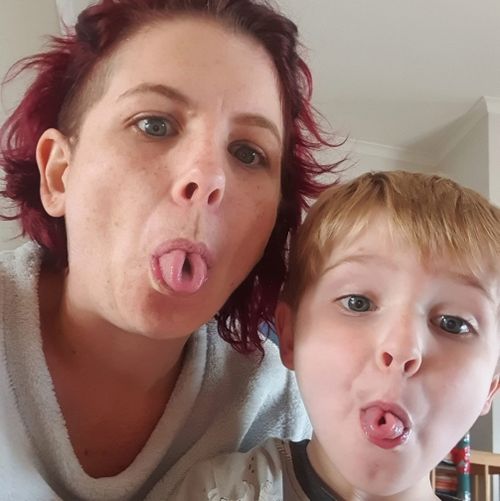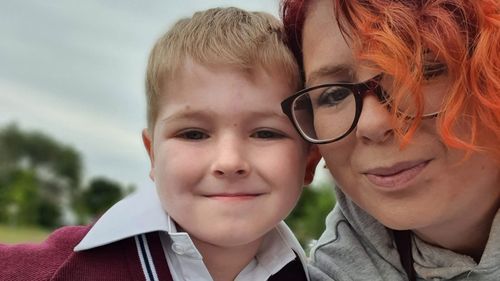Melbourne mum and hairdresser Gillian Jenkins was in the salon cutting a client’s hair when she suddenly felt her hand go numb.
“I walked over to the basin and I was thinking, ‘This isn’t normal’,” the 34-year-old said.
“Then my arm went numb, and my leg and my face. I started freaking out.”
READ MORE: Woman loses $37k to catfish posing as Aussie actor
But, almost as quickly as it came, the strange episode passed. Within minutes, Jenkins said she felt fine.
On the advice of a colleague, Jenkins saw a GP at a local medical centre, who did a blood test that didn’t show up anything out of the ordinary.
But, a week and a half later on Boxing Day, almost exactly the same thing happened again.
“I was out having lunch with a girlfriend and I went completely numb on my right side,” she said.
Jenkins’ friend called an ambulance and paramedics took her to Footscray Hospital.
While the numbness soon went away, Jenkins said she was left feeling nauseous and with a pounding headache.
At the hospital, a doctor ordered an electrocardiogram (ECG) and a blood test.
“Both of the tests came back clear and the doctor said he thought it was just anxiety and stress (causing the symptoms),” Jenkins said.
“I questioned that because I have never suffered anxiety in my life – but you take the doctor’s advice.”
READ MORE: Details of Shane Warne’s $20 million will revealed

Over the next week, things grew more frightening. On a day trip to the zoo with her seven-year-old son Thomas and 16-year-old step-daughter Annabelle, Jenkins fell ill with a splitting headache and began to lose her vision.
“It was quite scary, everything was blurry and I just couldn’t focus on anything. It was like there was a big blob in front of my face,” she said.
After a nap, Jenkins’ vision returned. But on New Year’s Day, she deteriorated again so her husband took her to Werribee Mercy Hospital.
There, doctors did more tests, including a CT scan, which led to some devastating news.
“They told me there were multiple lesions on my brain, one on my lung and possibly one on my kidney,” Jenkins said.
It turned out that a health scare Jenkins thought was well and truly in her past had come back to blindside her.
‘It was never meant to come back’
Four years ago, when Jenkins was 29, she developed a melanoma on her back.
The melanoma and its surrounding tissue were removed.
At the time, Jenkins was told she would not need any further treatment or scans, given the melanoma was so small.
Jenkins said she continued to get three-monthly skin checks in the intervening years, never missing an appointment.
It did not occur to Jenkins, or her doctors, to connect her past melanoma with her recent distressing symptoms because the skin cancer was considered such a low risk of returning, she said.
“It was never meant to come back,” she said.
“I thought it was all done and dusted. I was only meant to have a 1 per cent chance of getting melanoma again.”
However, a biopsy confirmed what doctors now suspected – the melanoma had returned.
Jenkins was diagnosed with stage four melanoma and a BRAF gene mutation was detected in the melanoma cells.
Her paralysis and vision loss were being caused by swelling on the brain.
Once doctors treated the swelling, Jenkins said the symptoms stopped.
Under the care of doctors at the Peter MacCallum Cancer Centre, Jenkins is now taking medication to target the BRAF mutation, before undergoing a year-long course of immunotherapy treatment.
With Jenkins unable to work because of the side effects of her medication, her aunt set up an online fundraiser to help the family with bills that are piling up.
“That actually made me cry. I’ve been so lucky that I have had so much support,” Jenkins said.
‘I was always in the sun’
Melanoma makes up roughly one-in-10 new cancer cases in Australia, where we have the highest incidence of the deadly skin cancer in the world.
Last year, an estimated 17,750 Australians were diagnosed with melanoma, according to Cancer Australia.
More advanced treatments and earlier diagnoses have lead to improved outcomes for melanoma patients over the past few decades, with 93 per cent now surviving at least five years.

Due to the success of past campaigns such as “Slip, Slop, Slap”, the risk for developing melanoma has more than halved for Australians aged under 30 since the 1980s.
Having grown up in the New South Wales coastal town of Port Stephens, Jenkins said much of her sun damage happened as a child.
“It was beach and bush – I was always out in the sun during my younger years,” she said.
“I often got burnt as a teenager and I didn’t really think much of it.”
Jenkins said despite the progress Australia had seen, she still came across some people who appeared to be complacent about the dangers of too much sun exposure.
Jenkins said she hoped her story would encourage others, particularly parents, to be vigilant about sun safety.
“Make sure you have always got a hat and sunscreen on your kids, even if it’s cloudy, there is still UV,” she said.
